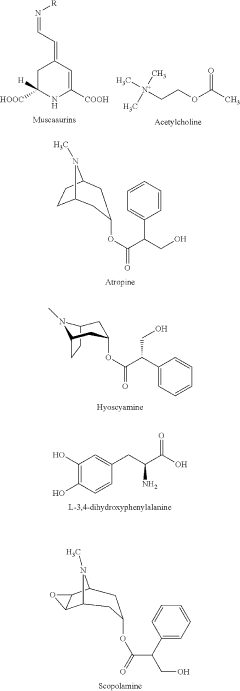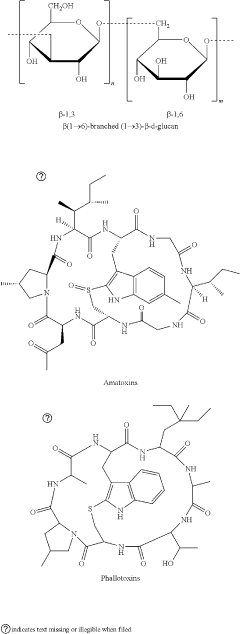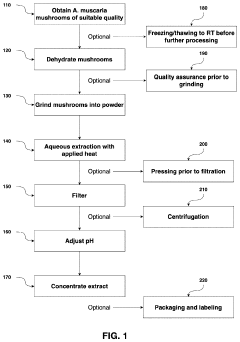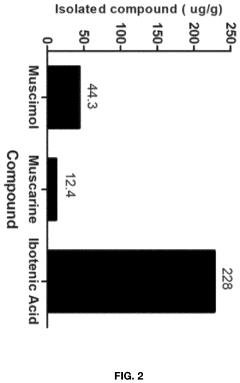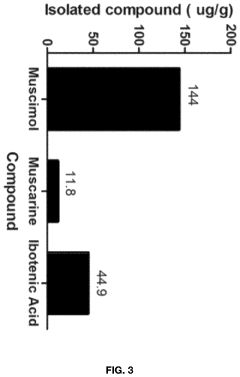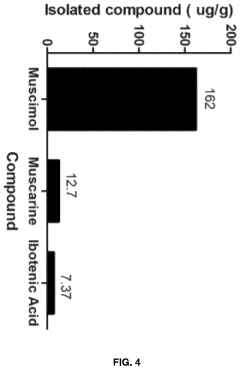Investigating the Psychoactive Potentials of Muscimol
JUL 4, 20259 MIN READ
Generate Your Research Report Instantly with AI Agent
Patsnap Eureka helps you evaluate technical feasibility & market potential.
Muscimol Background and Research Objectives
Muscimol, a psychoactive compound found primarily in Amanita muscaria mushrooms, has a rich history of traditional use and scientific interest. This naturally occurring GABA agonist has been utilized in various cultural practices for centuries, particularly in Siberian shamanic rituals. The compound's unique pharmacological properties have attracted increasing attention from researchers in recent decades, as they seek to understand its potential therapeutic applications and mechanisms of action.
The evolution of muscimol research has been marked by significant milestones. Early ethnobotanical studies in the mid-20th century documented its traditional use, while subsequent chemical isolation and characterization in the 1960s paved the way for more detailed pharmacological investigations. The discovery of muscimol's potent GABA-mimetic effects in the 1970s sparked a new wave of neuroscientific research, exploring its impact on brain function and behavior.
Recent technological advancements have enabled more sophisticated analyses of muscimol's neurochemical effects. High-resolution imaging techniques and advanced electrophysiological methods have provided unprecedented insights into its interactions with GABA receptors and its influence on neural circuits. These developments have not only enhanced our understanding of muscimol's psychoactive properties but also opened new avenues for potential therapeutic applications.
The primary objective of current muscimol research is to fully elucidate its psychoactive potential and explore its possible medical uses. This includes investigating its anxiolytic, anticonvulsant, and neuroprotective properties, as well as its potential role in treating various neurological and psychiatric disorders. Researchers are particularly interested in muscimol's ability to modulate GABAergic neurotransmission, which plays a crucial role in regulating mood, cognition, and neuroplasticity.
Another key research goal is to develop safer and more targeted delivery methods for muscimol. This involves exploring novel formulations and administration routes to optimize its therapeutic effects while minimizing potential side effects. Additionally, there is growing interest in synthesizing muscimol analogues with enhanced pharmacological profiles, potentially leading to new classes of GABA-based therapeutics.
As the field progresses, interdisciplinary collaboration has become increasingly important. Neuroscientists, pharmacologists, and clinicians are working together to bridge the gap between basic research and clinical applications. This collaborative approach aims to accelerate the translation of laboratory findings into potential treatments for conditions such as anxiety disorders, epilepsy, and neurodegenerative diseases.
In conclusion, the investigation of muscimol's psychoactive potentials represents a dynamic and evolving field of research. By building on historical knowledge and leveraging cutting-edge technologies, scientists are poised to unlock new insights into this fascinating compound's mechanisms and therapeutic potential. The ongoing research efforts hold promise for advancing our understanding of brain function and developing novel treatments for a range of neurological and psychiatric conditions.
The evolution of muscimol research has been marked by significant milestones. Early ethnobotanical studies in the mid-20th century documented its traditional use, while subsequent chemical isolation and characterization in the 1960s paved the way for more detailed pharmacological investigations. The discovery of muscimol's potent GABA-mimetic effects in the 1970s sparked a new wave of neuroscientific research, exploring its impact on brain function and behavior.
Recent technological advancements have enabled more sophisticated analyses of muscimol's neurochemical effects. High-resolution imaging techniques and advanced electrophysiological methods have provided unprecedented insights into its interactions with GABA receptors and its influence on neural circuits. These developments have not only enhanced our understanding of muscimol's psychoactive properties but also opened new avenues for potential therapeutic applications.
The primary objective of current muscimol research is to fully elucidate its psychoactive potential and explore its possible medical uses. This includes investigating its anxiolytic, anticonvulsant, and neuroprotective properties, as well as its potential role in treating various neurological and psychiatric disorders. Researchers are particularly interested in muscimol's ability to modulate GABAergic neurotransmission, which plays a crucial role in regulating mood, cognition, and neuroplasticity.
Another key research goal is to develop safer and more targeted delivery methods for muscimol. This involves exploring novel formulations and administration routes to optimize its therapeutic effects while minimizing potential side effects. Additionally, there is growing interest in synthesizing muscimol analogues with enhanced pharmacological profiles, potentially leading to new classes of GABA-based therapeutics.
As the field progresses, interdisciplinary collaboration has become increasingly important. Neuroscientists, pharmacologists, and clinicians are working together to bridge the gap between basic research and clinical applications. This collaborative approach aims to accelerate the translation of laboratory findings into potential treatments for conditions such as anxiety disorders, epilepsy, and neurodegenerative diseases.
In conclusion, the investigation of muscimol's psychoactive potentials represents a dynamic and evolving field of research. By building on historical knowledge and leveraging cutting-edge technologies, scientists are poised to unlock new insights into this fascinating compound's mechanisms and therapeutic potential. The ongoing research efforts hold promise for advancing our understanding of brain function and developing novel treatments for a range of neurological and psychiatric conditions.
Market Analysis for Psychoactive Compounds
The market for psychoactive compounds has been experiencing significant growth and transformation in recent years, driven by increasing research into their potential therapeutic applications and changing regulatory landscapes. Muscimol, a psychoactive compound found in Amanita muscaria mushrooms, is gaining attention in this evolving market.
The global psychedelic drugs market, which includes compounds like muscimol, is projected to expand rapidly. This growth is fueled by rising prevalence of mental health disorders, increasing acceptance of psychedelic drugs for treating these conditions, and ongoing clinical trials exploring their efficacy. North America currently dominates the market, with Europe following closely behind.
Muscimol's unique pharmacological profile positions it as a potential player in the treatment of neurological and psychiatric disorders. Its GABA-A receptor agonist properties make it particularly interesting for conditions such as anxiety, insomnia, and epilepsy. As research into muscimol's psychoactive potentials progresses, it could carve out a niche within the broader psychedelic therapeutics market.
The pharmaceutical industry is showing increased interest in psychoactive compounds, with several major companies investing in research and development. This trend is likely to benefit muscimol research, potentially leading to new drug formulations and delivery methods. Additionally, the wellness and nutraceutical sectors are exploring the use of sub-psychoactive doses of compounds like muscimol for cognitive enhancement and stress relief.
Regulatory changes are playing a crucial role in shaping the market for psychoactive compounds. While muscimol is not currently scheduled under the Controlled Substances Act in the United States, its legal status varies globally. The ongoing decriminalization and legalization of certain psychedelics in various jurisdictions may create new opportunities for muscimol-based products.
Consumer awareness and acceptance of psychoactive compounds for therapeutic use are growing, driven by media coverage and increasing scientific evidence. This shift in public perception is likely to contribute to market expansion. However, challenges remain, including stigma associated with psychoactive substances and the need for robust clinical evidence to support their use.
The market for muscimol and other psychoactive compounds faces competition from traditional pharmaceuticals and alternative therapies. To succeed, companies developing muscimol-based products will need to demonstrate clear therapeutic advantages and address safety concerns. Partnerships between research institutions, pharmaceutical companies, and biotechnology firms are likely to play a key role in advancing muscimol's market potential.
The global psychedelic drugs market, which includes compounds like muscimol, is projected to expand rapidly. This growth is fueled by rising prevalence of mental health disorders, increasing acceptance of psychedelic drugs for treating these conditions, and ongoing clinical trials exploring their efficacy. North America currently dominates the market, with Europe following closely behind.
Muscimol's unique pharmacological profile positions it as a potential player in the treatment of neurological and psychiatric disorders. Its GABA-A receptor agonist properties make it particularly interesting for conditions such as anxiety, insomnia, and epilepsy. As research into muscimol's psychoactive potentials progresses, it could carve out a niche within the broader psychedelic therapeutics market.
The pharmaceutical industry is showing increased interest in psychoactive compounds, with several major companies investing in research and development. This trend is likely to benefit muscimol research, potentially leading to new drug formulations and delivery methods. Additionally, the wellness and nutraceutical sectors are exploring the use of sub-psychoactive doses of compounds like muscimol for cognitive enhancement and stress relief.
Regulatory changes are playing a crucial role in shaping the market for psychoactive compounds. While muscimol is not currently scheduled under the Controlled Substances Act in the United States, its legal status varies globally. The ongoing decriminalization and legalization of certain psychedelics in various jurisdictions may create new opportunities for muscimol-based products.
Consumer awareness and acceptance of psychoactive compounds for therapeutic use are growing, driven by media coverage and increasing scientific evidence. This shift in public perception is likely to contribute to market expansion. However, challenges remain, including stigma associated with psychoactive substances and the need for robust clinical evidence to support their use.
The market for muscimol and other psychoactive compounds faces competition from traditional pharmaceuticals and alternative therapies. To succeed, companies developing muscimol-based products will need to demonstrate clear therapeutic advantages and address safety concerns. Partnerships between research institutions, pharmaceutical companies, and biotechnology firms are likely to play a key role in advancing muscimol's market potential.
Current State and Challenges in Muscimol Research
Muscimol research has made significant strides in recent years, with a growing body of scientific literature exploring its psychoactive properties and potential therapeutic applications. Currently, the primary focus of research is on understanding the pharmacological mechanisms of muscimol and its interactions with GABA receptors in the central nervous system.
One of the main challenges in muscimol research is the limited availability of high-quality, standardized muscimol for scientific studies. The extraction and purification processes from Amanita muscaria mushrooms can be complex and yield inconsistent results. This has led to efforts in developing synthetic production methods to ensure a reliable supply of pure muscimol for research purposes.
Another significant challenge is the need for more comprehensive human clinical trials to fully elucidate the effects and potential therapeutic benefits of muscimol. While animal studies have shown promising results in areas such as anxiety reduction and neuroprotection, translating these findings to human subjects requires overcoming regulatory hurdles and ethical considerations associated with psychoactive substance research.
The current state of muscimol research also faces challenges in terms of dosage optimization and delivery methods. As a GABA-A receptor agonist, muscimol's effects can be dose-dependent, and finding the right balance for therapeutic efficacy while minimizing side effects is crucial. Researchers are exploring various administration routes, including oral, sublingual, and transdermal applications, to enhance bioavailability and control onset and duration of effects.
Neuroimaging studies have provided valuable insights into muscimol's impact on brain activity, but more advanced techniques are needed to fully map its effects on neural networks and cognitive processes. This includes the use of functional MRI and EEG to better understand how muscimol modulates brain connectivity and influences various cognitive domains.
The legal and regulatory landscape surrounding muscimol research presents additional challenges. As a psychoactive compound, muscimol is subject to strict controls in many jurisdictions, which can impede research progress and limit the scope of studies. Efforts are underway to advocate for more flexible research policies that balance scientific inquiry with public safety concerns.
Lastly, there is a growing interest in exploring the potential synergistic effects of muscimol with other compounds found in Amanita muscaria, such as ibotenic acid and muscarine. This holistic approach aims to understand the entourage effect and how these compounds may work together to produce unique pharmacological profiles. However, this research direction adds complexity to study designs and requires careful consideration of safety and efficacy parameters.
One of the main challenges in muscimol research is the limited availability of high-quality, standardized muscimol for scientific studies. The extraction and purification processes from Amanita muscaria mushrooms can be complex and yield inconsistent results. This has led to efforts in developing synthetic production methods to ensure a reliable supply of pure muscimol for research purposes.
Another significant challenge is the need for more comprehensive human clinical trials to fully elucidate the effects and potential therapeutic benefits of muscimol. While animal studies have shown promising results in areas such as anxiety reduction and neuroprotection, translating these findings to human subjects requires overcoming regulatory hurdles and ethical considerations associated with psychoactive substance research.
The current state of muscimol research also faces challenges in terms of dosage optimization and delivery methods. As a GABA-A receptor agonist, muscimol's effects can be dose-dependent, and finding the right balance for therapeutic efficacy while minimizing side effects is crucial. Researchers are exploring various administration routes, including oral, sublingual, and transdermal applications, to enhance bioavailability and control onset and duration of effects.
Neuroimaging studies have provided valuable insights into muscimol's impact on brain activity, but more advanced techniques are needed to fully map its effects on neural networks and cognitive processes. This includes the use of functional MRI and EEG to better understand how muscimol modulates brain connectivity and influences various cognitive domains.
The legal and regulatory landscape surrounding muscimol research presents additional challenges. As a psychoactive compound, muscimol is subject to strict controls in many jurisdictions, which can impede research progress and limit the scope of studies. Efforts are underway to advocate for more flexible research policies that balance scientific inquiry with public safety concerns.
Lastly, there is a growing interest in exploring the potential synergistic effects of muscimol with other compounds found in Amanita muscaria, such as ibotenic acid and muscarine. This holistic approach aims to understand the entourage effect and how these compounds may work together to produce unique pharmacological profiles. However, this research direction adds complexity to study designs and requires careful consideration of safety and efficacy parameters.
Existing Methodologies for Muscimol Investigation
01 Muscimol as a psychoactive compound
Muscimol, a naturally occurring psychoactive compound found in certain mushroom species, has been studied for its potential therapeutic applications. It acts as a potent GABA receptor agonist, producing sedative, hypnotic, and hallucinogenic effects. Research has focused on understanding its mechanism of action and exploring its use in treating various neurological and psychiatric disorders.- Muscimol as a psychoactive compound: Muscimol, a naturally occurring psychoactive compound found in certain mushrooms, exhibits potent GABA-A receptor agonist properties. Its psychoactive effects include altered perception, mood changes, and potential therapeutic applications in neurological disorders.
- Pharmacological effects and mechanisms: Research into muscimol's pharmacological effects reveals its ability to modulate neurotransmitter systems, particularly GABA. Studies explore its potential in treating anxiety, depression, and cognitive disorders, as well as its impact on sleep patterns and memory formation.
- Synthetic production and analogs: Advancements in synthetic chemistry have led to the development of muscimol analogs and derivatives. These compounds aim to enhance therapeutic potential while minimizing adverse effects, opening new avenues for drug discovery in the field of neuropsychopharmacology.
- Safety profile and risk assessment: Ongoing research focuses on evaluating the safety profile of muscimol and its derivatives. Studies assess potential risks, toxicity levels, and long-term effects associated with its use, aiming to establish guidelines for therapeutic applications and recreational use.
- Delivery methods and formulations: Innovative delivery methods and formulations are being developed to optimize muscimol's bioavailability and targeted action. These include novel drug delivery systems, controlled-release formulations, and combination therapies to enhance its psychoactive and therapeutic potential.
02 Formulation and delivery methods
Various formulation and delivery methods have been developed to optimize the administration of muscimol for therapeutic purposes. These include oral, transdermal, and intranasal formulations, as well as novel drug delivery systems designed to enhance bioavailability and control release. Researchers have also explored combination therapies with other compounds to modulate muscimol's effects and reduce potential side effects.Expand Specific Solutions03 Therapeutic applications in neurological disorders
Muscimol's potential therapeutic applications in neurological disorders have been extensively investigated. Studies have explored its use in treating conditions such as epilepsy, Parkinson's disease, and chronic pain. The compound's ability to modulate GABA neurotransmission has shown promise in reducing seizures, improving motor function, and providing analgesic effects in preclinical and clinical trials.Expand Specific Solutions04 Psychiatric and cognitive effects
Research has examined muscimol's effects on psychiatric conditions and cognitive function. Studies have investigated its potential in treating anxiety disorders, depression, and substance abuse. Additionally, the compound's impact on memory, learning, and consciousness has been explored, with some research focusing on its potential to enhance cognitive performance or induce altered states of consciousness.Expand Specific Solutions05 Safety and toxicology studies
Comprehensive safety and toxicology studies have been conducted to assess the risks associated with muscimol use. These studies have evaluated acute and chronic toxicity, potential for addiction or dependence, and interactions with other medications. Researchers have also investigated methods to mitigate adverse effects and develop safer analogs or derivatives of muscimol with improved therapeutic profiles.Expand Specific Solutions
Key Players in Psychoactive Compound Research
The investigation into the psychoactive potentials of muscimol is currently in an early stage of development, with the market still emerging and relatively small. The technology is not yet fully mature, but there is growing interest from both pharmaceutical and research institutions. Companies like ACADIA Pharmaceuticals, DemeRx, and CaaMTech are at the forefront of exploring muscimol's potential, while established players such as Novartis and Neurocrine Biosciences are also showing interest. The competitive landscape is diverse, with a mix of specialized biotech firms and larger pharmaceutical companies. As research progresses, we can expect increased competition and potential collaborations, particularly in developing novel treatments for neurological and psychiatric disorders.
ACADIA Pharmaceuticals, Inc.
Technical Solution: ACADIA Pharmaceuticals is investigating the psychoactive potentials of muscimol through its proprietary drug discovery platform. The company is developing novel small molecule compounds that target the GABA-A receptor, similar to muscimol's mechanism of action. Their approach involves using structure-guided drug design to create compounds with enhanced selectivity and potency compared to natural muscimol[1]. ACADIA's research aims to exploit muscimol's anxiolytic and sedative properties while minimizing potential side effects. The company is exploring the use of muscimol derivatives in treating neuropsychiatric disorders, including anxiety, insomnia, and certain forms of epilepsy[2].
Strengths: Extensive experience in CNS drug development, proprietary drug discovery platform. Weaknesses: Potential regulatory hurdles, competition from other psychoactive compounds.
DemeRx, Inc.
Technical Solution: DemeRx is exploring the psychoactive potential of muscimol as part of its broader research into ibogaine and its derivatives. The company is investigating the synergistic effects of combining muscimol with ibogaine-based compounds to enhance therapeutic outcomes in addiction treatment[3]. Their approach involves developing a novel formulation that leverages muscimol's GABA-A receptor agonist properties to modulate the psychoactive effects of ibogaine. DemeRx is conducting preclinical studies to assess the safety and efficacy of this combination therapy, with a focus on reducing withdrawal symptoms and cravings in opioid addiction[4].
Strengths: Innovative approach combining muscimol with ibogaine derivatives, potential for enhanced addiction treatment. Weaknesses: Early-stage research, regulatory complexities of combination therapies.
Breakthrough Studies on Muscimol's Psychoactive Effects
Amanita muscaria compounds
PatentPendingUS20240050502A1
Innovation
- Development of purified Amanita muscaria compound compositions and formulations comprising specific ratios of ibotenic acid, muscimol, and other compounds, which are structurally distinct and free from other Amanita muscaria compounds, combined with excipients and serotonergic drugs, psilocybin derivatives, or cannabinoids to create pharmaceutical formulations for therapeutic use.
Processes for Extracting Muscimol from Amanita Muscaria
PatentPendingUS20240165180A1
Innovation
- Aqueous extraction of Amanita muscaria biomass is performed with heat, followed by pH reduction between 2.0 to 4.0 and concentration through distillation or refluxing, which decreases ibotenic acid content and increases muscimol content, resulting in a muscimol-rich extract with enhanced purity.
Regulatory Framework for Psychoactive Substances
The regulatory framework for psychoactive substances plays a crucial role in governing the research, development, and potential therapeutic applications of compounds like muscimol. In the United States, the Drug Enforcement Administration (DEA) classifies psychoactive substances into schedules based on their potential for abuse and accepted medical use. Currently, muscimol is not specifically scheduled but falls under the Federal Analogue Act, which treats substances with similar chemical structures to controlled substances as Schedule I drugs.
Internationally, the United Nations Office on Drugs and Crime (UNODC) oversees global drug control efforts through various conventions. The 1971 Convention on Psychotropic Substances provides a framework for regulating psychoactive compounds, although muscimol is not explicitly listed. Many countries have adopted similar scheduling systems to the United States, with variations in specific substance classifications.
Research on psychoactive substances like muscimol typically requires special licenses and approvals from regulatory bodies. In the US, the Food and Drug Administration (FDA) oversees clinical trials involving psychoactive compounds, while the National Institute on Drug Abuse (NIDA) provides guidelines for preclinical research. The process for obtaining research approval involves rigorous safety protocols, ethical considerations, and demonstrated scientific merit.
Recent shifts in regulatory approaches have seen some jurisdictions adopting more progressive policies towards certain psychoactive substances. For example, several US states and countries have decriminalized or legalized the use of psilocybin for therapeutic purposes. These changes may pave the way for more nuanced regulations surrounding compounds like muscimol, potentially facilitating research and development.
The pharmaceutical industry faces significant challenges in navigating the complex regulatory landscape for psychoactive substances. Developing new therapies based on compounds like muscimol requires substantial investment in clinical trials and regulatory compliance. However, the potential for breakthrough treatments in mental health and neurology continues to drive interest in this field.
As research into the psychoactive potentials of muscimol progresses, regulatory frameworks may need to evolve to accommodate new scientific findings and potential therapeutic applications. This could involve creating new categories for substances with unique pharmacological profiles or revising existing scheduling criteria. Balancing public safety concerns with the need for scientific advancement remains a key challenge for policymakers and regulatory bodies in this domain.
Internationally, the United Nations Office on Drugs and Crime (UNODC) oversees global drug control efforts through various conventions. The 1971 Convention on Psychotropic Substances provides a framework for regulating psychoactive compounds, although muscimol is not explicitly listed. Many countries have adopted similar scheduling systems to the United States, with variations in specific substance classifications.
Research on psychoactive substances like muscimol typically requires special licenses and approvals from regulatory bodies. In the US, the Food and Drug Administration (FDA) oversees clinical trials involving psychoactive compounds, while the National Institute on Drug Abuse (NIDA) provides guidelines for preclinical research. The process for obtaining research approval involves rigorous safety protocols, ethical considerations, and demonstrated scientific merit.
Recent shifts in regulatory approaches have seen some jurisdictions adopting more progressive policies towards certain psychoactive substances. For example, several US states and countries have decriminalized or legalized the use of psilocybin for therapeutic purposes. These changes may pave the way for more nuanced regulations surrounding compounds like muscimol, potentially facilitating research and development.
The pharmaceutical industry faces significant challenges in navigating the complex regulatory landscape for psychoactive substances. Developing new therapies based on compounds like muscimol requires substantial investment in clinical trials and regulatory compliance. However, the potential for breakthrough treatments in mental health and neurology continues to drive interest in this field.
As research into the psychoactive potentials of muscimol progresses, regulatory frameworks may need to evolve to accommodate new scientific findings and potential therapeutic applications. This could involve creating new categories for substances with unique pharmacological profiles or revising existing scheduling criteria. Balancing public safety concerns with the need for scientific advancement remains a key challenge for policymakers and regulatory bodies in this domain.
Ethical Considerations in Psychoactive Research
The ethical considerations in psychoactive research, particularly concerning muscimol, are multifaceted and require careful examination. At the forefront is the principle of informed consent, which is paramount when conducting studies involving human subjects. Researchers must ensure that participants fully understand the potential risks and benefits associated with muscimol exposure, including its psychoactive effects and possible long-term consequences.
Safety protocols and risk management strategies are crucial components of ethical research in this field. Given the potent nature of muscimol, stringent measures must be in place to monitor participants' physical and psychological well-being throughout the study. This includes comprehensive medical screenings, continuous health monitoring, and immediate access to medical intervention if needed.
The potential for addiction or substance abuse is another significant ethical concern. While muscimol is not typically associated with high addiction potential, researchers must consider the possibility of psychological dependence or misuse. Implementing robust follow-up procedures and providing support resources for participants post-study is essential to address these concerns.
Privacy and confidentiality are critical ethical considerations, especially given the sensitive nature of psychoactive research. Researchers must implement robust data protection measures to safeguard participants' personal information and study results. This includes anonymizing data, secure storage protocols, and strict access controls.
The broader societal implications of muscimol research must also be considered. There is a responsibility to accurately communicate findings to the public and policymakers, avoiding sensationalism or misrepresentation that could lead to misuse or misconceptions about the substance.
Ethical review boards play a crucial role in ensuring that research protocols adhere to established ethical guidelines. These boards must carefully evaluate the risk-benefit ratio of muscimol studies, ensuring that the potential scientific and medical benefits outweigh the risks to participants and society.
Lastly, researchers must consider the ecological and cultural implications of muscimol research. As muscimol is derived from certain mushroom species, there are concerns about sustainable sourcing and potential impacts on natural ecosystems. Additionally, the cultural significance of these mushrooms in some indigenous traditions must be respected, necessitating engagement with relevant communities and consideration of traditional knowledge in research approaches.
Safety protocols and risk management strategies are crucial components of ethical research in this field. Given the potent nature of muscimol, stringent measures must be in place to monitor participants' physical and psychological well-being throughout the study. This includes comprehensive medical screenings, continuous health monitoring, and immediate access to medical intervention if needed.
The potential for addiction or substance abuse is another significant ethical concern. While muscimol is not typically associated with high addiction potential, researchers must consider the possibility of psychological dependence or misuse. Implementing robust follow-up procedures and providing support resources for participants post-study is essential to address these concerns.
Privacy and confidentiality are critical ethical considerations, especially given the sensitive nature of psychoactive research. Researchers must implement robust data protection measures to safeguard participants' personal information and study results. This includes anonymizing data, secure storage protocols, and strict access controls.
The broader societal implications of muscimol research must also be considered. There is a responsibility to accurately communicate findings to the public and policymakers, avoiding sensationalism or misrepresentation that could lead to misuse or misconceptions about the substance.
Ethical review boards play a crucial role in ensuring that research protocols adhere to established ethical guidelines. These boards must carefully evaluate the risk-benefit ratio of muscimol studies, ensuring that the potential scientific and medical benefits outweigh the risks to participants and society.
Lastly, researchers must consider the ecological and cultural implications of muscimol research. As muscimol is derived from certain mushroom species, there are concerns about sustainable sourcing and potential impacts on natural ecosystems. Additionally, the cultural significance of these mushrooms in some indigenous traditions must be respected, necessitating engagement with relevant communities and consideration of traditional knowledge in research approaches.
Unlock deeper insights with Patsnap Eureka Quick Research — get a full tech report to explore trends and direct your research. Try now!
Generate Your Research Report Instantly with AI Agent
Supercharge your innovation with Patsnap Eureka AI Agent Platform!

